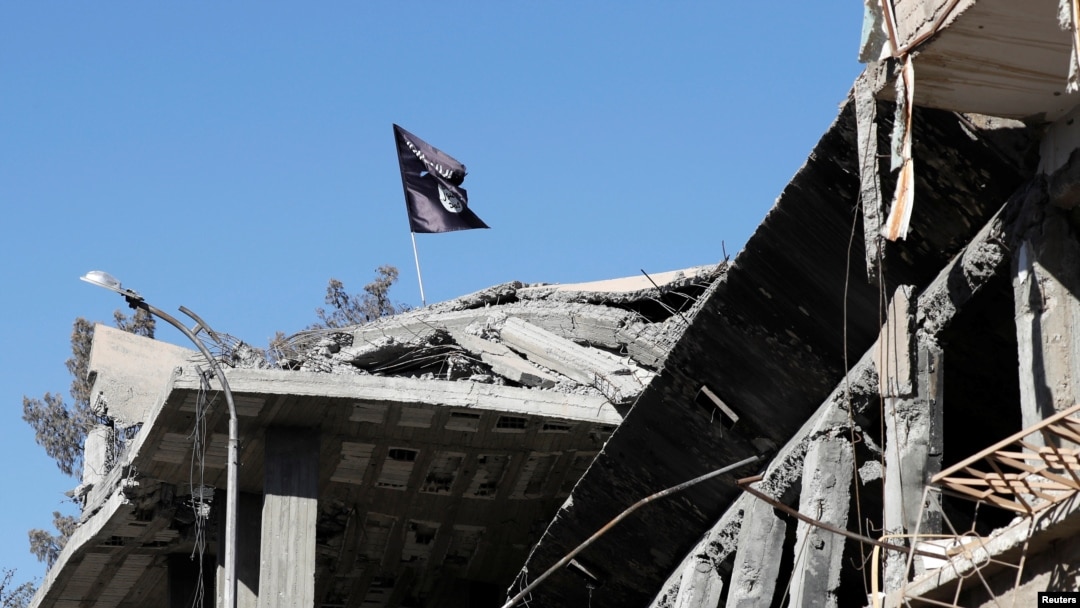Word from the Islamic State terror group that it had lost its second leader in less than a year came as no surprise to the United States, which had been aware of his demise for more than a month.
IS, also known as ISIS or Daesh, announced the death of Abu al-Hassan al-Hashimi al-Qurashi in a short audio statement Wednesday, with spokesman Abu Umar al-Muhajir saying, "He died fighting the enemies of God, killing some of them before being killed like a man on the battlefield."
U.S. Central Command later issued its own statement, confirming Abu al-Hassan was killed in mid-October in Syria’s southern Daraa province by the Free Syrian Army (FSA), a rebel group that does not partner with the U.S.
But despite the lack of American involvement in the operation, U.S. officials were quickly brought in to examine the results.
Based on evidence at the scene and subsequent DNA testing, the U.S. determined the FSA had in fact killed Abu al-Hassan, a U.S. defense official, speaking on the condition of anonymity in order to discuss the intelligence, told VOA.
The U.S. official did not say why the U.S. refused to confirm the IS leader's death until now, nor have U.S. defense and intelligence officials explained how they were able to identify him though DNA, as Abu al-Hassan is not his real name but a nom de guerre.
Intelligence gathered by United Nation member states and published in July suggested Abu al-Hassan was most likely one of two people – Juma'a Awwad Ibrahim al-Badri, the brother of former IS leader Abu Bakr al-Baghdadi, or Abd al-Raouf al-Muhajir, who led the IS general directorate of provinces.
Other, earlier reports suggested Abu al-Hassan was Iraqi national Bashar Khattab Ghazal al-Sumaida'i, but Turkish officials confirmed in recent months that al-Sumaida'i as been in their custody since May, following a raid in Istanbul.
SEE ALSO: Turkish Officials Claim Capture of New Islamic State LeaderThe London-based Syrian Observatory for Human Rights, a war monitoring group that was among the first to report on a series of FSA raids that led to the IS leader’s death, on Wednesday gave his real name as Abd Al-Rahman Al-Iraqi.
SEE ALSO: Islamic State Group Still Active in Southern Syria, Observers SayRegardless, U.S. officials welcomed the announcement of the IS leader’s death.
"We are pleased to see the removal of ISIS' top leaders in such quick succession," said White House press secretary Karine Jean-Pierre, noting the death of the group’s previous leader this past February.
SEE ALSO: US Calls Death of Islamic State Leader 'Significant Blow'"We will build on these counterterrorism successes," she added. "We'll keep that pressure on for sure."
Abu al-Hassan’s death, while not at the hands of the U.S., is the latest in a series of heavy blows to the terror group’s leadership.
In addition to the death of Abu al-Hassan’s predecessor in February and the arrest of al-Sumaida'i in May, IS has lost at least five other senior officials in the past eight months.
Hani Ahmed al-Kurdi, a key leader for the group's Syrian operations, was captured in a U.S. helicopter raid in June.
SEE ALSO: US Nabs Rising Islamic State Official in Syria RaidA U.S. drone strike in July killed Maher al-Agal, said to be the top IS official in Syria.
SEE ALSO: US Says Drone Strike Kills Senior Al-Qaida Leader in PakistanThen, in October, a U.S. raid in the northeastern Syria village of Qamishli killed Rakkan Wahid al-Shammri, a longtime IS operative and smuggler.
The U.S. followed up less than 24 hours later with an airstrike that killed two more top IS officials: Abu 'Ala, described as one of the terror group's "top five," and Abu Mu'Ad al-Qahtani, the IS official responsible for prisoner affairs.
SEE ALSO: US Strikes IS Leadership Twice in 24 HoursEven before the most recent operations targeting IS, U.S. officials had said the terror group had essentially been forced into survival mode by "a major talent loss in ISIS senior leadership."
"[It] has caused them to focus on kind of branch expansion that has diffused the threat and, again, made the focus on the United States less acute than we had seen in prior years," National Counterterrorism Center Director Christine Abizaid told a conference this past September.
The terror organization has also seen its ranks thin considerably. Intelligence estimates shared by the U.S. and by U.N. member states indicate IS has gone from commanding possibly upwards of 20,000 fighters in the months after the collapse of the last remnant of its self-declared caliphate in Syria, to overseeing perhaps as few as 6,000 across Syria and Iraq.
The task of leading IS now falls to Abu al-Hussein al-Husseini al-Qurashi, named as the group's new emir in the same statement announcing Abu al-Hassan’s death.
"He is one of the veteran warriors and one of the loyal sons of the Islamic State," said IS spokesman al-Muhajir.
According to JihadoScope, a company that monitors jihadi activity on social media, some IS followers have already began pledging their allegiance, or bay'ah, to the new leader.
In the past, IS followed the announcement of a new leader with social media campaigns showing followers around the world pledging their support.


